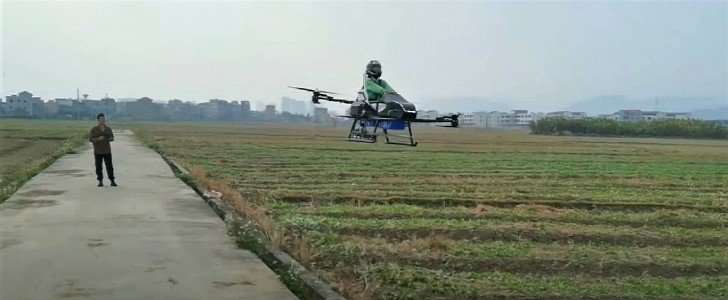The idea of vertical takeoff and landing (VTOL) aircraft has grown in popularity in recent years. And for a good reason. As cities become more crowded, traffic congestion is also becoming a problem that can't be ignored. So companies are already racing to put their VTOLs up in the skies in hopes of ending traffic jams.
Shared or personal VTOLs could be the future of urban mobility. However, seeing air taxis fly above our heads will not happen overnight, that's for sure. Intracity and intercity travel won't be possible without a fully-implemented infrastructure. This implies building takeoff and landing sites for these aircraft, a high-speed communication network, and more.
But companies don't seem to wait for that, as they're making great strides in developing various VTOL designs. Recently, a Chinese company developed a hybrid aircraft that successfully took to the skies with its first passenger, reports Xinhua.
The flight took place on Saturday, December 26th, in Guangxi. The aircraft was created by a group of Chinese aviation enthusiasts. It's not the first time when they're venturing into VTOL territory, as in 2015, they designed a hybrid unmanned helicopter.
Their latest creation is an octocopter that is remote-controlled by an operator. The VTOL has room for just one passenger, and it can carry a payload that weighs 220 lbs (100 kg) for up to one hour. Aside from these specifications, we don't get much information about its speed or the maximum height that can be reached.
That's because the project is still in its beginning stage. As a result, there's room for improvement in its design. For example, safety cannot be ensured since the rotors seem to be placed a little too close to the passenger. Moreover, the team could also choose to encase the rotors in the future as an extra safety measure, but they'll need to take into consideration the extra weight.
There are also some concerns about vehicle stability. However, all of these and more will probably be addressed. Nonetheless, it's an interesting vehicle that aced its maiden flight. Take a look at the clip down below to see it in action.
But companies don't seem to wait for that, as they're making great strides in developing various VTOL designs. Recently, a Chinese company developed a hybrid aircraft that successfully took to the skies with its first passenger, reports Xinhua.
The flight took place on Saturday, December 26th, in Guangxi. The aircraft was created by a group of Chinese aviation enthusiasts. It's not the first time when they're venturing into VTOL territory, as in 2015, they designed a hybrid unmanned helicopter.
Their latest creation is an octocopter that is remote-controlled by an operator. The VTOL has room for just one passenger, and it can carry a payload that weighs 220 lbs (100 kg) for up to one hour. Aside from these specifications, we don't get much information about its speed or the maximum height that can be reached.
That's because the project is still in its beginning stage. As a result, there's room for improvement in its design. For example, safety cannot be ensured since the rotors seem to be placed a little too close to the passenger. Moreover, the team could also choose to encase the rotors in the future as an extra safety measure, but they'll need to take into consideration the extra weight.
There are also some concerns about vehicle stability. However, all of these and more will probably be addressed. Nonetheless, it's an interesting vehicle that aced its maiden flight. Take a look at the clip down below to see it in action.







